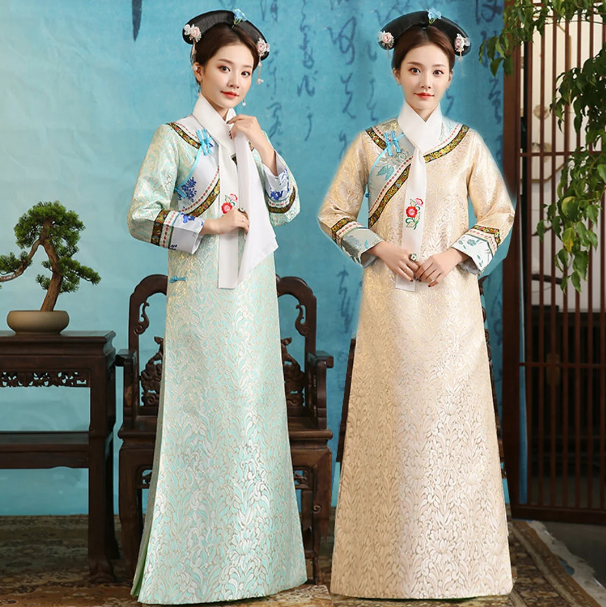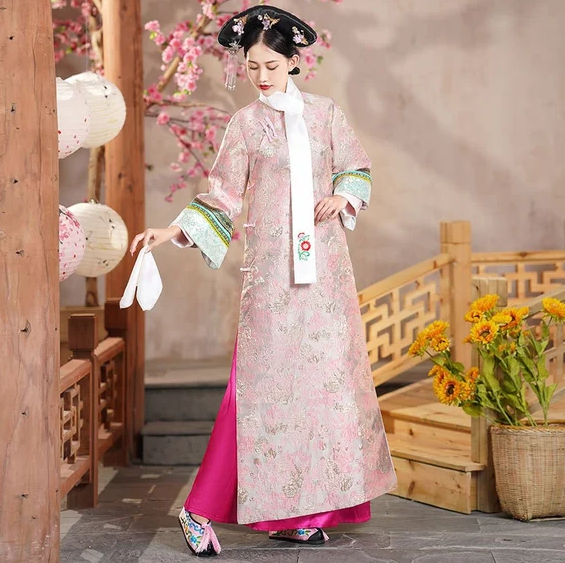Historical Roots of the Cheongsam
The Cheongsam, also known as Qipao, has a storied past deeply rooted in Chinese history, emerging from the rich tapestry of China’s dynasties.
Manchu Ethnic Clothing Origins
The Cheongsam originated from the traditional attire of the Manchu people. This ethnic group, hailing from Northeast China, brought their distinct clothing styles when they conquered the Ming Dynasty and established the Qing Dynasty. Their clothing, designed for horseback riding and active life, featured straight cuts and was typically loose-fitting to provide ease of movement.

Transformation into Han Chinese Fashion
As the Qing Dynasty progressed, the Han Chinese began adopting the Manchu clothing style. Over time, the loose Manchu robes evolved, influenced by the Han preference for form-fitting garments. Tailors started to design Cheongsams that accentuated the body shape, making the garment popular among upper-class Han Chinese women by the 20th century. This marked a significant shift as the Cheongsam became a symbol of fashion and modernity in Chinese society.
Distinctions in Design
The Cheongsam stands out with its distinctive fusion of traditional Manchu tailoring and Han Chinese aesthetics.
Characteristics of Traditional Manchu Attire
Traditional Manchu attire was practical, with a focus on ease of movement. Garments often had a straight-cut and roomy design, suitable for the Manchu’s equestrian lifestyle. Outfits typically included a long robe called a “changpao,” which covered the wearer from neck to foot.
Divergence into the Cheongsam Design
The Cheongsam diverged significantly from its Manchu roots in the early 20th century. Tailors began emphasizing body contours, introducing features like side slits for mobility and aesthetic appeal. They incorporated luxurious fabrics and intricate details, transforming the Cheongsam into a fashion statement. The iconic garment began to symbolize the emancipation of women, as it allowed more freedom of movement than traditional Han attire and reflected the progressive attitudes of the era.
Cheongsam: Cultural Adoption and Adaptation
The Cheongsam reflects a deep intermingling of Manchu and Han Chinese cultural elements, signifying a remarkable journey from ethnic dress to a symbol of Chinese identity.
Manchu Influence on Cheongsam
Initially, the Cheongsam was a Manchu ethnic dress; its loose fit allowed for horse riding and archery. However, as it was adopted by the Han majority, the design evolved to become more form-fitting and elaborate, reflecting Han tastes.
Integration into the Broader Chinese Culture
By the mid-20th century, the Cheongsam had become a pan-Chinese phenomenon, shedding its ethnic limitations. This garment began to feature in international exhibitions and was praised for its elegance and distinctiveness, thus integrating it into the broader narrative of Chinese cultural heritage.
This transition not only reflects a change in aesthetics but also signifies the blending and preservation of cultural identities within China’s diverse ethnic landscape. The Cheongsam, once a simple Manchu outfit, had been reinvented as a national symbol, worn by women across the country, and recognized globally for its unique beauty and sophistication.
Socio-Political Influence on Cheongsam
Cheongsam stands as a cultural icon, reflecting China’s historical shifts and societal evolution.
The Manchu Rule and its Impact on Chinese Dress
Manchu ascendancy enforced their dress codes, prompting Han Chinese to blend these with local styles. Women integrated Manchu designs, crafting the precursor to modern Cheongsam.
National Identity and the Cheongsam’s Evolution
After the Qing Dynasty’s collapse, Chinese citizens embraced the Cheongsam to express a new national identity. Its evolution mirrored societal changes, becoming a fashion statement and a national symbol.
The Cheongsam’s resilience over time signifies China’s cultural adaptability and strength. Women wore it proudly, combining tradition with modernity, and making a statement against Western fashion dominance. The Cheongsam has been more than clothing; it’s a declaration of Chinese endurance and pride.
Cheongsam in Literature and Art
The Cheongsam frequently adorns the pages of novels and canvases, symbolizing Chinese aesthetics.
Depictions of Manchu Attire in Historical Records
Early texts document the Manchu attire strictly, emphasizing its role in social hierarchy. The Cheongsam’s precursors, as described in Qing Dynasty records, highlighted modesty and status.
The Cheongsam’s Representation in Modern Media
In modern films and artwork, the Cheongsam often represents femininity and cultural nostalgia. Media portrays the garment as a blend of traditional Chinese values with a touch of modern freedom. Artists and directors use the Cheongsam to evoke a bygone era, bridging the past and present of Chinese culture.
The Future of the Cheongsam
The Cheongsam, a cultural gem, stands at the crossroads of tradition and innovation.

Preserving Manchu Heritage in Cheongsam
Designers incorporate traditional motifs to honor the garment’s Manchu origins. These efforts ensure the Cheongsam remains a vessel of cultural heritage. Museums and cultural centers hold exhibitions showcasing the evolution of the Cheongsam, educating the public on its significance.
Modern Interpretations and Cheongsam’s Cultural Significance
Contemporary fashion reimagines the Cheongsam for global audiences. This reinvention keeps the Cheongsam relevant in the fast-paced world of fashion. The Cheongsam’s cultural significance is evident as it appears in global events, bridging cultures and showcasing Chinese influence. Designers present new collections annually, with sales figures often reaching thousands, indicating its enduring appeal. They balance aesthetic appeal with material quality to ensure the longevity of each piece. As a cultural symbol, the Cheongsam carries the narrative of Chinese history and its diaspora’s experiences, reflecting its time-honored value beyond mere aesthetics.







